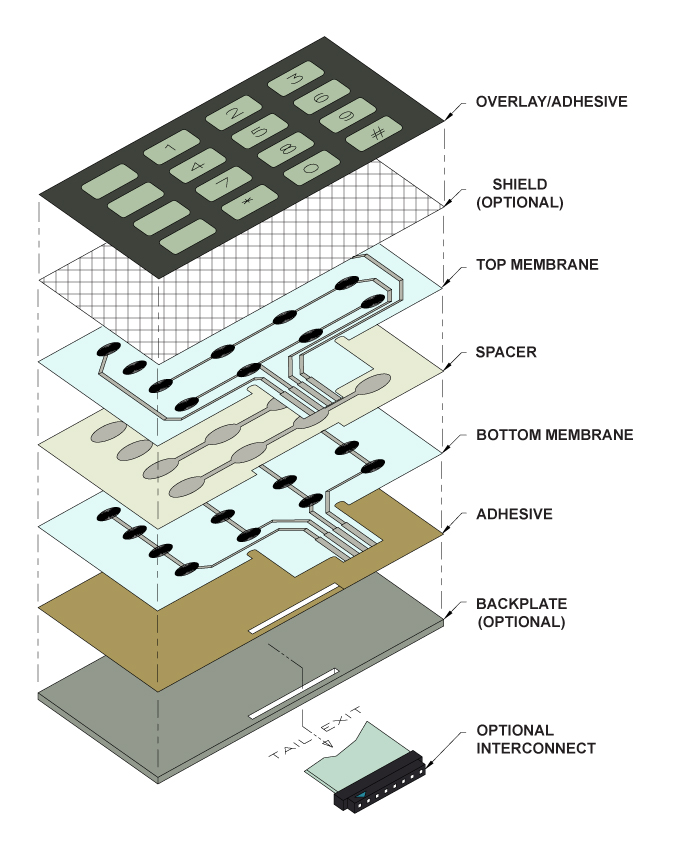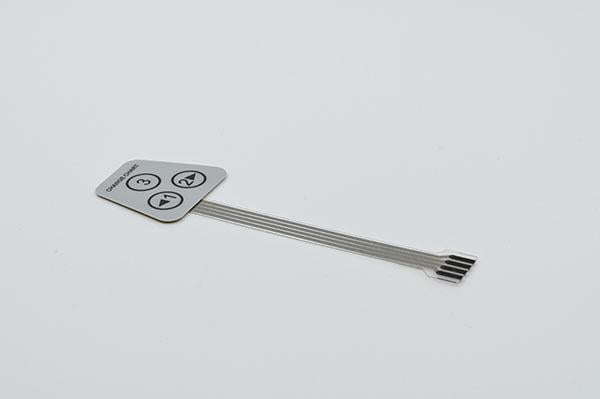A reputable membrane switch manufacturer offers both sample and bulk options.
A reputable membrane switch manufacturer offers both sample and bulk options.
Blog Article
What to Seek When Picking a Membrane Layer Switch Over for Your Project
When you're picking a membrane layer button for your project, numerous crucial elements come into play. You'll need to think concerning the materials, design, and how well it lines up with your brand.
Recognizing Membrane Layer Switch Components
When you plunge right into the world of membrane buttons, it's crucial to realize the essential parts that make them work. Under that, the spacer layer assurances there's sufficient distance in between the circuit and the overlay, enabling the button to trigger without constant stress.
The circuit layer, typically made from published conductive inks, creates the electrical paths. When you press a button, the circuit closes, sending a signal to the device. Recognizing just how these layers collaborate helps you select a membrane layer switch that's reputable and fits your task requirements. Pay close interest to the density and material of each layer, as these elements affect durability and capability in various atmospheres.
Product Selection and Its Influence
Selecting the right materials for your membrane switch can considerably affect its efficiency and long life. The selection of substratum, normally polyester or polycarbonate, affects sturdiness and versatility. Polyester is a lot more abrasion-resistant, while polycarbonate offers much better quality and stamina.
Following, consider the adhesive. It requires to withstand environmental variables like dampness and temperature level adjustments. A solid adhesive guarantees that your membrane button stays intact with time.
Do not forget the visuals overlay. The printing approach utilized, whether silkscreen or digital, affects the switch's appearances and long life. High-quality inks will certainly resist fading and scratching, keeping a professional look.
Last but not least, consider environmental problems. If your tool will certainly be exposed to harsh chemicals or severe temperature levels, pick products developed to sustain these difficulties. Your choices in materials will inevitably establish the button's dependability and user contentment.
Layout Considerations for Customer Experience
Selecting the right materials lays the foundation for an effective membrane button, but the style also plays a considerable function in user experience. You'll intend to reflect on how the layout influences usability (membrane switch manufacturer). Maintain buttons and symbols intuitive and well-spaced, making it easy for users to navigate without complication

Shade and contrast are also important; guarantee that your design is visually attractive however still functional. High contrast assists customers easily determine switches, specifically in low-light problems.
Lastly, mirror on the total aesthetic. A sleek and contemporary style can boost customer perception and make your item a lot more enticing. Balancing performance with an engaging design will result in a much better customer experience and inevitably, a more successful product.

Environmental Elements and Toughness
When selecting a membrane button, you need to think about how it'll carry out in numerous settings. Variables like temperature resistance, moisture and chemical direct exposure, and mechanical wear can substantially influence its longevity. Recognizing these elements will aid you choose a switch that takes on your details problems.
Temperature Level Resistance Needs
As environmental problems can differ extensively, understanding temperature level resistance is essential for ensuring the resilience of your membrane button. You require to assess the temperature range in which your tool will certainly run. Heats can create products to deteriorate, bring about failure, while reduced temperature levels might make elements brittle and vulnerable to splitting. Make certain to check the requirements of the materials made use of in the switch, like the sticky and overlay, as they straight effect performance. It's also wise to consider possible temperature changes and their effects on the switch's integrity. By selecting a membrane layer button with appropriate temperature resistance, you'll improve its life expectancy and keep performance in challenging environments. Select wisely to avoid pricey substitutes down the line.

Moisture and Chemical Direct Exposure
Dampness and chemical direct exposure can greatly impact the performance and durability of your membrane button, so it's important to understand the atmosphere in which it will certainly be utilized. If your job includes high humidity or exposure to liquids, look for safety coatings and sealers that can improve resistance to dampness. Additionally, consider the sorts of chemicals your button might encounter. Certain materials can degrade when exposed to solvents, oils, or harsh cleansers. Picking the ideal products, like polycarbonate or polyester, can aid stand up to these components. Constantly speak with the producer's specs for chemical compatibility to guarantee your membrane switch preserves its performance in time. By focusing on moisture and chemical resistance, you can boost the durability of your button in tough settings.
Mechanical Put On and Tear
While you may prioritize attributes like aesthetic appeals and functionality in your membrane switch, mechanical wear and tear can substantially affect its efficiency over time. Frequent pushing can lead to destruction of materials, causing problems like tactile responses loss click this or also switch failing. Picking a resilient switch guarantees longevity and reliability, protecting against pricey replacements and downtime in your task.
Modification Options for Branding
When it comes to branding your membrane switch, customization options are key. You can select style components and colors that show your brand name, along with particular logo placement and dimension to boost visibility. In addition, picking the ideal materials and structures can boost the general feel and look, making your product stick out.
Layout Elements and Colors
A broad variety of style elements and shades can make your membrane switch not just functional but additionally visually enticing, boosting your brand name identity. Don't neglect concerning textures; adding a responsive component can improve customer experience and make your switch stand out. By attentively choosing style aspects and shades, you not only produce an item that looks great yet additionally strengthens your branding consistently and effectively.
Logo Design Positioning and Dimension
After settling your style elements and shades, the next action is to concentrate on logo placement and dimension. Your logo is an essential element of your branding, so you'll want it to stick out without frustrating other layout components. Mirror on where your logo will be most visible and impactful; common positionings consist of the leading or facility of the switch.
Think of the size also-- as well huge and it could eclipse practical elements, too tiny and it might get lost. Objective for a balance that allows go now your logo to be easily well-known while preserving the total looks. Do not forget to consider exactly how the logo aligns with individual communication. This focus to detail will certainly boost both capability and brand name identification in your task.
Material and Appearance Options
Choosing the ideal materials and structures for your membrane layer button can significantly enhance both its performance and visual appeal. You'll intend to evaluate options like polyester or polycarbonate, as they use toughness and resistance to use. The structure of the surface additionally plays a necessary role; smooth finishes provide a streamlined appearance, while distinctive surface areas can enhance grip and tactile comments.
Customizing the materials and appearances allows you to mirror your brand identification successfully. You could choose a matte surface to share class or a shiny look for a modern touch. Don't forget shade options, as dynamic colors can make your button stick out, while muted tones can produce a more sophisticated look
Cost vs. Quality: Locating the Right Balance
When you're handling the alternatives for membrane buttons, balancing expense and high quality can really feel frustrating. You intend to guarantee that you're getting a reliable item without damaging the financial institution. Start by identifying your project's specific requirements. Are you focusing on longevity or looks? A lower-cost button could conserve you cash upfront, but if it compromises functionality, you might deal with higher substitute costs later on.
Seek makers that offer a good mix of price and high requirements. Study their credibility and consumer evaluations to determine dependability. Sometimes, investing a bit a lot more in high quality materials can conserve you from future headaches.
Also, take into consideration the long-lasting efficiency and service warranty choices. A a little extra expensive button with a solid service warranty can confirm to be a smarter financial investment. Ultimately, it's regarding discovering that pleasant place where you meet your budget plan while ensuring your project's success.
Examining and Top Quality Assurance Protocols
While you may find the excellent membrane layer switch design, guaranteeing its high quality through strenuous testing protocols is crucial for long-term success. Start by validating that the manufacturer adheres to market standards, such as IPC/WHMA-A -620, to ensure a reliable item. membrane switch manufacturer. You'll intend to inspect for extensive screening techniques, including ecological, mechanical, and electrical analyses
Make sure the buttons go through resilience screening, simulating real-world use to determine any possible failures. Focus on the manufacturer's top quality guarantee procedure, which ought to include regular examinations and audits.

Do not neglect to ask for examples and perform your own tests to validate compatibility with your task. Take into consideration how frequently the maker updates their procedures; technology in testing can lead to enhanced high quality. By prioritizing these screening and quality control procedures, you'll increase the likelihood of a successful and durable membrane layer button for your application.
Often Asked Inquiries
The length of time Does a Membrane Switch Usually Last?
A membrane switch commonly lasts anywhere from 1 to 10 million cycles, relying on usage and ecological elements. You'll intend to think about your specific requirements to guarantee it fulfills your long life requirements effectively.
Can Membrane Layer Switches Be Fixed if Damaged?
Yes, you can often fix membrane layer switches if they're damaged, however it usually relies on the level of the browse around this site damage. Small concerns may be fixable, while much more significant damages generally needs replacement for correct performance.
What Are the Common Applications for Membrane Buttons?
Membrane buttons are commonly used in home appliances, medical tools, and automobile controls. You'll discover them in consumer electronics, industrial equipment, and even video gaming consoles. Their convenience makes them perfect for numerous user interfaces and atmospheres.
Exist Specific Accreditations for Membrane Layer Switches?
Yes, there specify qualifications for membrane layer buttons. Seek UL, CE, and RoHS accreditations to guarantee safety and conformity. These certifications suggest the switch fulfills sector requirements for high quality and ecological safety and security.
Exactly how Do I Make Certain Correct Setup of a Membrane Layer Switch Over?
To guarantee proper installation of a membrane layer button, tidy the surface area completely, straighten it carefully, and apply even pressure. Adhere to producer guidelines for sticky curing time to make the most of sturdiness and capability.
Verdict
When selecting a membrane layer button for your job, keep these essential aspects in mind: prioritize resilient products, emphasis on user-friendly layout, and take into consideration customization for your brand. By thoroughly assessing these aspects, you'll ensure your membrane layer button not only meets your job requires but also boosts individual experience and reflects your brand name identity properly.
Report this page